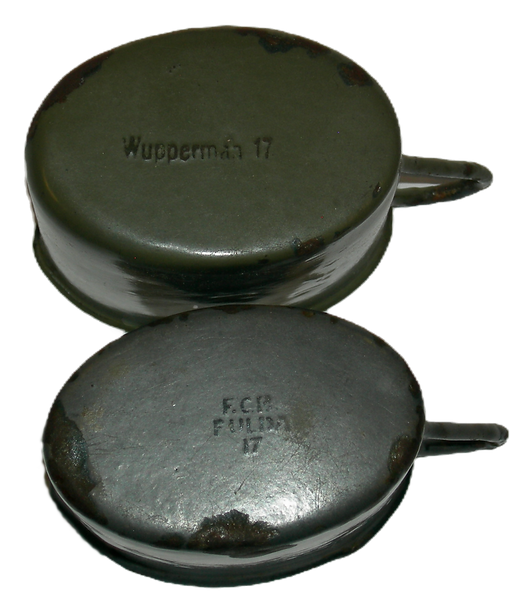
Drinking Cup
tringk·be·cher
(Trinkbecher)
M1893 - Aluminum Cup
(M.1893 Trinkbecher)
The aluminum drinking cup ( was introduced in 1893 together with the new M1893 canteen. The basic outlining shape of it' was oval. The approx. dimensions: 7.5 x 5 x 10 cm, has a curved edge, a pronounced spout, and holds ¼ L. depending on the manufacturer, two tick marks are indented on the side. At the back, the cup had with six aluminum rivets attaching a hinge plate for two handlebars made of a thick aluminum 'wire'. It is on this hinge plate, you should be able to find a manufacturers mark located there.
It should be noted that the drinking cup was carried in the bread bag; in practice, the cup would be hooked onto the canteen when attached to the bread bag. However, it was quickly figured out that on the front lines, such a practice would easily betray a soldier by the 'tinking' noise produced by the rattling cup, so soldiers secluded their cups inside their bread bags.
Post War Note:
The cup was reintroduced for the Reichswehr without a strongly pronounced spout . The cup itself continued to be produced until 1940.











M1915 Transitional - Tinned Steel
(M. 1915 Trinkbecher)
As aluminum became not only scarce but a strategic resource, the war ministry declared in October 1914 had the aluminum cup discontinued and transition production over to a tinned plated steel cup. This was accomplished as of early 1915, the plate attaching the wire handles. They also had the same indentations on the side like the earlier model, along with the measurement of ¼ L. Essentially these cups were identical to the earlier Model 1893, aside from war time changes. These M1915 cup was only produced in 1915 and 1916 when the Model 1916 Enameled Cups took their place.



M1916 - Enameled Cup
(M.1916 Trinkbecher)
Introduced March 1916, the Model 1916 enameled cup was introduced to replace the tinned steel cup introduced in the previous year. It was made out of enameled steel sheet and had a single steel looped handle. The enamel varied in color from a stone grey to green to blue in color. Indents were typically found on the side with a 'painted' ¼ L on it's side, a common feature of the issued cups. Makers marks were typically on the bottom side of the cup. It should be noted that these cups are typically seen with imperfections (chips) and thus not safe to drink from. It is very rare to find a 'perfect' enameled cup.




